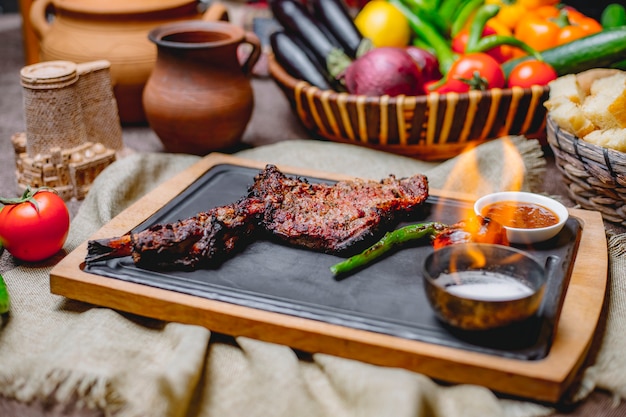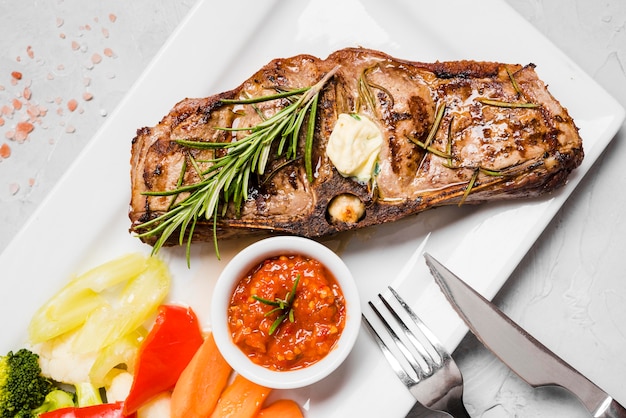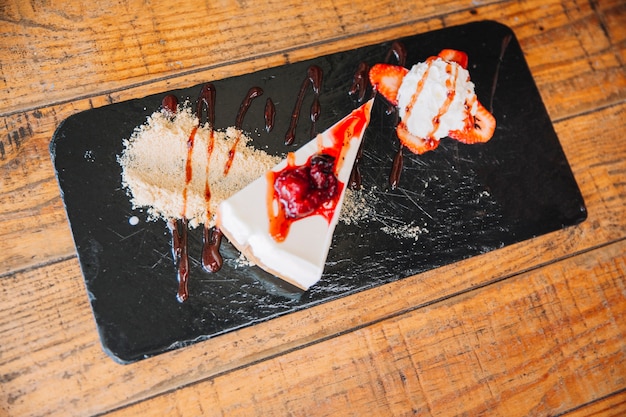Ever dreamt of carving a perfectly cooked, succulent prime rib roast? The kind that melts in your mouth and makes everyone go "Wow!"? Then you've come to the right place. Let's be honest, a prime rib roast can seem intimidating - it's not exactly a quick weeknight dinner, is it? But I'm here to tell you, with the right guidance, even a beginner can master this culinary masterpiece.
Over the years, I've tackled my fair share of prime rib roasts, and let me tell you, I've learned a thing or two. I've made my fair share of mistakes, too! But those missteps have led me to discover the best techniques for achieving that succulent, melt-in-your-mouth perfection.
This guide is your blueprint for prime rib nirvana, covering everything from choosing the perfect cut to mastering the art of roasting, and even throwing in some of my favorite accompaniments. Grab a cuppa, get cozy, and let's embark on this journey to create the prime rib roast of your dreams!
(Part 1) Choosing the perfect prime rib: The Foundation of Flavor

The first step to a knockout prime rib roast is getting your hands on the right cut of meat. It's the foundation of everything, so don't skimp!
What is Prime Rib?
Prime rib, also known as standing rib roast, is a cut of beef taken from the primal rib section of the cow. Imagine a big, beautiful slab of meat, typically weighing between 3 and 8 pounds - that's what you're dealing with!
The most popular cut for prime rib is the "rib roast," which includes ribs 6 through 12. You'll often see it labeled as "standing rib roast" because it's usually sold with the bones still attached. This adds to the visual appeal and also contributes to the flavor as the bones help in the roasting process.
Understanding the Grades: Prime, Choice, or Select?
Now, when you're buying prime rib, you'll notice different grades listed, like "Select," "Choice," and "Prime." These grades are a way of indicating the amount of marbling, or intramuscular fat, in the meat. More marbling means more flavor and tenderness, so it's a good thing!
Prime is the highest grade, offering the most marbling and the best overall quality. But let's be real, it can be pricier. Don't be afraid to go for a slightly lower grade, like Choice. It's still an excellent cut, especially if you plan to cook it slowly and allow the fat to render, adding richness to the roast. You can even look for "Choice" with "prime-like marbling" to get the best of both worlds.
(Part 2) The Secret to Tenderness: Resting Your Prime Rib

Alright, you've got your prime rib - now what? Before you even think about putting it in the oven, we need to talk about resting. This is a critical step, often overlooked, but it's the secret to a juicy, flavorful prime rib.
Think of it this way: when you cook meat, the muscle fibers tighten up, making the meat firmer. But when you let the meat rest, those fibers relax, allowing the juices to redistribute throughout. The result? A more tender, flavorful roast that practically melts in your mouth.
So, how do you rest your prime rib? I recommend letting it rest at room temperature for at least 30 minutes to an hour before roasting. This helps the meat come closer to room temperature, leading to more even cooking. Also, pat it dry with paper towels to remove any excess moisture. This helps achieve a nice crispy crust.
(Part 3) Seasoning Your Prime Rib: A Symphony of Flavors

Now we're getting to the fun part! Seasoning your prime rib is like adding the finishing touches to a beautiful piece of art. It's the final touch that brings everything together. The key is to use simple, bold flavors that will enhance the natural taste of the beef.
The Basics: Salt and Pepper, the Essential Duo
Start with the basics – salt and pepper. These are the foundation of any good seasoning. I prefer kosher salt for its larger crystals, which allow for a more even distribution. Don't be shy – use a generous amount!
Beyond the Basics: Exploring a World of Flavor
But we're not stopping there! There's a whole world of flavors just waiting to be explored. Some of my personal favorites for prime rib include:
- Garlic Powder: Adds a savory depth of flavor, like a warm hug for your taste buds.
- Onion Powder: Creates a subtle, sweet, and savory note that dances on your tongue.
- Paprika: Adds a touch of warmth and color, making the roast look as good as it tastes.
- Herbs: Rosemary, thyme, and sage are classic choices for prime rib, bringing a touch of earthiness.
- Dried Herbs: I like to use a blend of dried herbs, like oregano, basil, and marjoram, for a more complex flavor profile.
dry rub or Wet Brine: Choosing Your Approach
You've got options when it comes to applying your seasonings. You can create a dry rub by simply combining your chosen spices and rubbing it onto the meat. Or, you can create a wet brine by dissolving salt, sugar, and herbs in water and submerging the meat for a few hours.
I personally prefer a dry rub, as I find it creates a more flavorful crust. But a wet brine can be helpful for tenderizing tougher cuts of meat and adding additional moisture to the roast. Ultimately, it comes down to personal preference. Experiment and find what works best for you!
(Part 4) Mastering the Art of Roasting: A Symphony of Heat
We're in the home stretch now. The moment of truth has arrived - it's time to roast that prime rib! This is where your patience and attention to detail will pay off.
The Oven Temperature: The Starting Point for Perfection
Start by preheating your oven to 450°F (232°C). This high initial temperature will create a nice, crisp crust on the outside.
The roasting time: A Guide to Doneness
The roasting time will depend on the size of your roast and the desired level of doneness. Here's a general guideline:
| Weight (lbs) | Time (at 450°F) | Time (at 325°F) |
|---|---|---|
| 3-4 lbs | 15 minutes | 1 ??-2 hours |
| 4-6 lbs | 20 minutes | 2-2 ?? hours |
| 6-8 lbs | 25 minutes | 2 ??-3 hours |
The first 15-25 minutes at the high temperature are crucial for building that beautiful crust. Then, you'll lower the oven temperature to 325°F (163°C) and continue cooking until the desired level of doneness is reached.
Doneness: A Matter of Personal Taste
When it comes to doneness, it's all about personal preference. Here's a general guide, but ultimately, your taste buds will guide you:
- Rare: 125°F (52°C) - The meat will be red in the center, with a cool, tender texture.
- Medium-Rare: 130°F (54°C) - The center will be pink, with a warmer temperature and a slightly firmer texture than rare.
- Medium: 140°F (60°C) - The center will be mostly brown, with a firm texture.
- Medium-Well: 150°F (66°C) - The center will be mostly brown, with a very firm texture.
- Well Done: 160°F (71°C) - The center will be completely brown, with a very firm texture.
To check for doneness, use a meat thermometer. Insert it into the thickest part of the roast, making sure to avoid touching any bones.
Basting for Juiciness: Locking in the Flavor
You can baste your prime rib with pan drippings throughout the roasting process to help keep it moist and flavorful. To do this, simply spoon the drippings over the roast every 30-45 minutes. The drippings will add a beautiful sheen and a rich, savory taste to the roast.
The Importance of Resting (Again!): A Final Touch for Tenderness
Just like before cooking, resting after cooking is crucial. It allows the juices to redistribute, resulting in a more tender and flavorful roast. Let the prime rib rest for at least 15-20 minutes before carving. Cover it loosely with foil to keep it warm and let those juices settle in.
(Part 5) Carving Your Prime Rib with Confidence: A Celebration of Effort
Okay, you've done the hard work! Your prime rib roast is cooked to perfection, and now it's time to carve it up. Don't worry, it's not as scary as it seems. It just takes a little practice.
First things first, you need the right tools. A sharp carving knife is a must! It will slice through the meat with ease. Also, a carving fork is handy to hold the roast steady while you carve.
Now, let's break down the carving process:
Step 1: Remove the Bones: Liberating the Roast
If you're working with a bone-in roast, the first step is to remove the ribs. This makes carving the meat much easier. To do this, use your carving knife to carefully separate the meat from the bone. You might need to gently pry the bone away from the meat.
Step 2: Slice Across the Grain: Unlocking Tenderness
Once the bones are removed, start carving slices across the grain of the meat. This means slicing perpendicular to the muscle fibers. Slicing this way helps to break down the fibers, resulting in a more tender and juicy roast.
Step 3: Carve into Serving-Sized Pieces: Sharing the Bounty
Once you have sliced the roast, you can carve it into serving-sized pieces. I find that slices about ?? inch thick are a good size, allowing for a generous portion for each guest.
Step 4: Arrange the Meat: A Feast for the Eyes
Arrange the carved meat on a platter or serving dish. You can keep it warm by placing the platter on a warming tray, or in a preheated oven on low heat.
(Part 6) Accompanying Your Prime Rib: A Feast for the Senses
Now that your prime rib roast is cooked to perfection, it's time to think about the accompaniments. These are the side dishes that will complete your meal and create a symphony of flavors.
Classic Pairings: Timeless Combinations
Some classic pairings for prime rib include:
- Roasted Potatoes: A simple yet satisfying side dish that complements the richness of the roast. The crispy exterior and fluffy interior of roasted potatoes provide a delightful contrast to the tender meat.
- Creamed Spinach: The creamy richness of creamed spinach provides a nice contrast to the meat. The earthy flavor of spinach also complements the savory notes of the prime rib.
- Yorkshire Pudding: A traditional English side dish that's fluffy and savory. Yorkshire pudding is a perfect complement to prime rib because it soaks up the delicious pan drippings, creating a symphony of flavors.
- green bean casserole: A classic comfort food that always goes down well with prime rib. The creamy sauce and crispy fried onions add a touch of nostalgia and sweetness to the meal.
Beyond the Classics: Exploring New Horizons
But feel free to get creative! There are endless possibilities for side dishes to pair with your prime rib. Here are a few of my favorites:
- roasted brussels sprouts with Bacon: A delicious and festive side dish that adds a smoky and salty element to the meal. The slight bitterness of Brussels sprouts is balanced by the sweetness of bacon, creating a perfect harmony.
- asparagus with lemon and parmesan: A light and refreshing side dish that adds a tangy touch. The crisp asparagus spears, brightened by the zest of lemon and the salty bite of Parmesan, cleanse the palate and complement the rich prime rib.
- Garlic mashed potatoes: A creamy and comforting side dish that’s always a crowd-pleaser. The smooth, buttery texture of garlic mashed potatoes is a perfect companion for the hearty prime rib.
- Roasted Root Vegetables: A colorful and flavorful side dish that’s packed with nutrients. The earthy sweetness of roasted carrots, beets, and parsnips adds a vibrant dimension to the meal.
Sauces for the Win: Elevating the Experience
Don't forget about the sauces! A good sauce can elevate your prime rib to a whole new level. Here are some classic and delicious options:
- Au Jus: A simple sauce made from pan drippings, water, and seasonings. It's a light and flavorful sauce that complements the roast perfectly. The natural juices of the meat, enhanced by the herbs and spices, create a rich and savory sauce.
- Horseradish Sauce: A tangy and spicy sauce that adds a kick to the roast. The sharp flavor of horseradish cuts through the richness of the meat, providing a delightful contrast.
- Red Wine Sauce: A rich and complex sauce that’s perfect for a special occasion. The deep flavors of red wine, enhanced by herbs and aromatics, create a luxurious sauce that elevates the prime rib to new heights.
(Part 7) Leftovers: Don’t Waste a Bite!
You’ve done it! You’ve cooked the perfect prime rib. But what happens when you have leftovers? Don’t despair! prime rib leftovers are just as delicious as the original.
Here are a few ways to use up those leftover prime rib scraps:
- Prime Rib Sandwiches: Slice the leftover prime rib into thin strips and layer them on bread with your favorite toppings. A simple mustard, onion, and pickle sandwich elevates the leftover prime rib to a new level of deliciousness.
- Prime Rib Salad: Dice up the leftover prime rib and add it to a salad for a hearty and flavorful meal. A mix of greens, vegetables, and a light vinaigrette complements the rich flavor of the prime rib.
- Prime Rib Soup: Use the leftover prime rib to add flavor to a hearty soup. The meat adds a depth of flavor to a classic beef broth, creating a satisfying and comforting soup.
- Prime Rib Hash: Dice up the leftover prime rib and add it to a hash with potatoes, onions, and peppers. The hash is a hearty and flavorful meal, perfect for a brunch or a light dinner.
(Part 8) FAQs: Prime Rib Wisdom
Alright, so now that you’re armed with all this prime rib knowledge, you might have a few burning questions. Don’t worry, I’ve got you covered.
Q: How long should I cook prime rib for rare, medium-rare, and medium?
A: The cooking time will vary depending on the size of your roast, but here’s a general guideline:
- Rare: 125°F (52°C) – about 14-18 minutes per pound
- Medium-Rare: 130°F (54°C) – about 16-20 minutes per pound
- Medium: 140°F (60°C) – about 18-22 minutes per pound
Remember to check for doneness with a meat thermometer, as these times are just a general guide. It's always better to err on the side of undercooked, as you can always cook it a bit longer if needed.
Q: What happens if I overcook my prime rib?
A: If you overcook your prime rib, it will become dry and tough. It's best to err on the side of undercooked, as you can always cook it a bit longer if needed. The key is to check the internal temperature with a meat thermometer to ensure it reaches your desired level of doneness.
Q: Can I cook prime rib in a slow cooker?
A: Yes, you can cook prime rib in a slow cooker, but it won't have the same crispy crust as a roasted prime rib. If you're looking for a more tender and flavorful roast, a slow cooker is a good option. Just be sure to adjust the cooking time accordingly, as slow cookers generally operate at a lower temperature than ovens.
Q: Can I freeze prime rib?
A: Yes, you can freeze prime rib. Wrap it tightly in plastic wrap and then in aluminum foil. It can be frozen for up to 3 months. Thaw the roast in the refrigerator for 2-3 days before cooking. Freezing and thawing can impact the texture, so it's best to cook frozen prime rib as a roast, rather than slicing it for sandwiches or other dishes.
Q: What’s the best way to reheat leftover prime rib?
A: The best way to reheat leftover prime rib is in a slow oven. Preheat the oven to 250°F (121°C) and place the prime rib in a roasting pan. Heat for about 30 minutes, or until warmed through. This method helps to retain the moisture and tenderness of the meat.
Everyone is watching

Perfect Rice Every Time: The Ultimate Guide to Cooking Rice
Cooking TipsAs a self-proclaimed foodie, I've always been a bit obsessed with rice. It's the foundation of countless cuisi...

Prime Rib Roast Cooking Time Chart: Per Pound Guide
Cooking TipsPrime rib roast. Just the name conjures images of lavish dinners, crackling fires, and hearty laughter. It’s ...

The Ultimate Guide to Cooking Asparagus: Tips, Techniques, and Recipes
Cooking TipsAsparagus. The mere mention of this spring delicacy conjures up images of vibrant green spears, crisp and burs...

Ultimate Guide to Cooking the Perfect Thanksgiving Turkey
Cooking TipsThanksgiving. Just the word conjures up images of overflowing tables laden with delicious food, the scent of r...

How Long to Bake Potatoes in the Oven (Perfect Every Time)
Cooking TipsBaked potatoes are a staple in my kitchen. They're incredibly versatile, delicious, and surprisingly easy to m...
